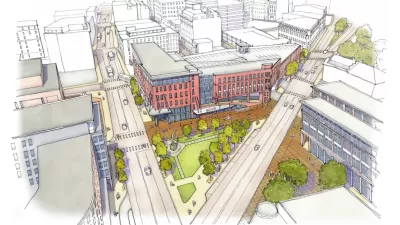As central cities become prized by young professionals and the companies that want to lure them, it behooves states to recognize the value of the historic buildings that bring unique character to workplaces and urban environs, writes Kaid Benfield.
Providence, Rhode Island was lucky to have a weak economy a few decades ago, says Benfield. As other cities replaced their historic buildings with "newer but mediocre buildings," Providence missed out, leaving its downtown historic legacy intact.
"Providence may be a particularly fine example, but it is hardly the only city with underutilized historic assets that could become a cornerstone of future economic development," he explains. "Information has largely replaced manufacturing as America’s economic engine, and young, talented workers today are seeking walkable districts with character in which to work and live. (Just ask suburban Dublin, Ohio about that.) From Pasadena to Portland, from Paducah to Providence, saving and sprucing up these assets is the way to go."
However, states such as Rhode Island and Missouri, have dismantled, or are considering dismantling, preservation incentives that are crucial to renovating and reusing historic properties.
"Providence is sometimes thought of as a declining city, but to me it seemed more like a promising one – poised for rebirth, fueled by the country’s emerging economy and demographics," he adds. "Its chances – like those of other, similarly situated communities – will be enhanced if it (1) recognizes the impressive assets that it has; (2) builds upon those assets by courting the right kinds of businesses and residents that appreciate character and walkability; and (3) preserves those assets for the future, starting with re-enacting the state’s historic property tax credit."
FULL STORY: The case for building on a city's historic assets

Alabama: Trump Terminates Settlements for Black Communities Harmed By Raw Sewage
Trump deemed the landmark civil rights agreement “illegal DEI and environmental justice policy.”

Planetizen Federal Action Tracker
A weekly monitor of how Trump’s orders and actions are impacting planners and planning in America.

The 120 Year Old Tiny Home Villages That Sheltered San Francisco’s Earthquake Refugees
More than a century ago, San Francisco mobilized to house thousands of residents displaced by the 1906 earthquake. Could their strategy offer a model for the present?

In Both Crashes and Crime, Public Transportation is Far Safer than Driving
Contrary to popular assumptions, public transportation has far lower crash and crime rates than automobile travel. For safer communities, improve and encourage transit travel.

Report: Zoning Reforms Should Complement Nashville’s Ambitious Transit Plan
Without reform, restrictive zoning codes will limit the impact of the city’s planned transit expansion and could exclude some of the residents who depend on transit the most.

Judge Orders Release of Frozen IRA, IIJA Funding
The decision is a victory for environmental groups who charged that freezing funds for critical infrastructure and disaster response programs caused “real and irreparable harm” to communities.
Urban Design for Planners 1: Software Tools
This six-course series explores essential urban design concepts using open source software and equips planners with the tools they need to participate fully in the urban design process.
Planning for Universal Design
Learn the tools for implementing Universal Design in planning regulations.
Clanton & Associates, Inc.
Jessamine County Fiscal Court
Institute for Housing and Urban Development Studies (IHS)
City of Grandview
Harvard GSD Executive Education
Toledo-Lucas County Plan Commissions
Salt Lake City
NYU Wagner Graduate School of Public Service





























